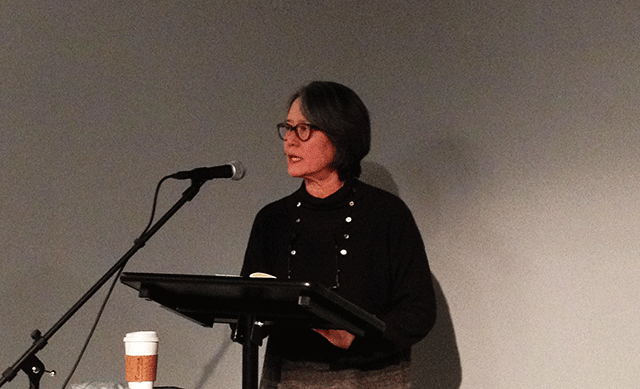
Novelist Ruth Ozeki was in New York’s unofficial sixth borough, Jersey City, to celebrate the release of the paperback edition of her novel A Tale for the Time Being. Brooklyn’s WORD Bookstore opened a second store in Jersey City late last month; Ozeki became the first author to read in the new space and she described the store as having that “new bookstore smell.”
A Tale for the Time Being follows Nao (pronounced “now”), a teenage girl in Tokyo writing diary entries, and a novelist, Ruth, who finds the diary washed ashore in British Columbia. Nao spent part of her life in California before returning to Tokyo, where she was bullied.
The novel began, Ozeki explains, in 2006 with the voice of Nao. Often Ozeki finds the voices of her characters develop even before a story for the novel. The voice that came to her spoke what since has become the first line in the book: “Hi, my name is Nao and I am a time being. Do you know what a time being is? Well if you give me a moment I’ll tell you.” As Ozeki reads the line, she slides into the voice of a teenager. She is practiced in reading with the inflections and tonality of a teenage girl, and it feels a natural voice as she reads.
Though the teenage voice is well captured, Ozeki later explained her only real knowledge of how teenagers speak is her own experience years earlier. Partly too she has a strong knowledge of Japanese pop-culture and that gives her access to the world of a modern teen girl in Japan. Ultimately though, when it comes to voice, “it’s either there or it’s not.”
At the time she began writing the novel, Ozeki says she had been reading a series of essays by Dōgen Zenji, a 13th century Buddhist philosopher, including his musing on Uji, translated in various ways to mean time-being, time and existence and the existence of time. The voice of the teenage girl Ozeki found herself writing felt as though a teenage girl translating Zenji’s musings on time.
Then Ozeki reads from the Ruth section of the novel. The voice shifts, and between Nao’s diary and Ruth, the writer, the tone shifts clearly with a distinctly different narrative voice. Ruth was not always a character in the novel, and Ozeki said she had about fifteen hundred pages of Nao’s diary written before deciding on Ruth.
Most writers eventually end up writing about the relationship between writer and reader, Ozeki says. A Tale for the Time Being is hers version of this concept. The novel is about the relationship between Nao, the writer, and Ruth, the reader, and though Nao came easily to her, finding the correct reader was a laborious process. Writers and readers collaborate, Ozeki says, co-creating the world of the story together.
Ozeki spent four years searching for a reader character for Nao, and considered three or four different possible candidates. She resisted inserting a version of herself into the novel saying it felt too meta. And anytime a novelist names a character after herself, Ozeki explains, there are going to be questions about autobiography. She has other Ruth-like characters in previous books. One of them she made very physically different to help distance the character from herself. The second doppelgänger has an unpleasant personality, and readers are reluctant to link the author with an unpleasant character. But Ruth, the character, and Ruth Ozeki, the author, are much more closely related.
In 2010, Ozeki had a finished draft, but no reader character to interact with Nao. The whole novel was Nao’s diary. She was making final edits before submitting the novel to her editor when the earthquake and subsequent tsunami struck Japan. Her book was a pre-earthquake novel but now she was living in a post-earthquake world.
Once she decided to add Ruth to the novel as Nao’s reader, writing the new sections of the book moved along quickly. Suddenly she had a new way of accessing the story. She had a new draft ready in six months. The device that had once seemed too self indulgent now seemed appropriate.
She says that in writing the book, she learned a lot about patience. “It was a lesson in time,” Ozeki says.
Much of her writing process is an organic exploration. As she writes, she will find herself researching topics that lead to new things to write, and new questions, and more research, in one ongoing cycle. She describes her novels as “sprawly” partly as a result of this process. Her novels are “reflections of the world” that lead her “where the story takes me.”
“You sit with the story without knowing where its going and you have to be okay with that,” she says.